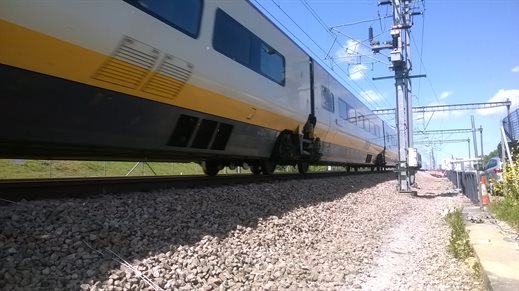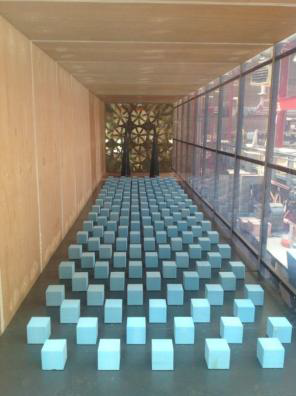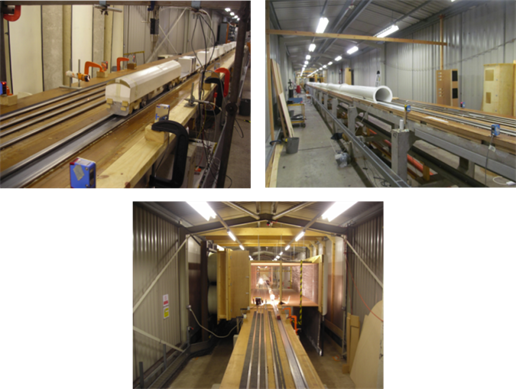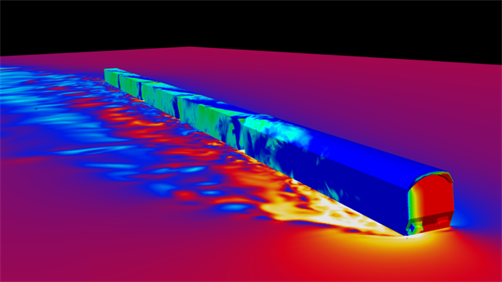Aerodynamic phenomena are traditionally studied in a variety of ways: full-scale measurements, model-scale testing and Computational Fluid Dynamics (CFD) simulations. The University of Birmingham's train aerodynamics research group has expertise in the above methods and have used their facilities to conduct a variety of research and commercial projects.
Full-scale measurements
Full-scale measurements of train aerodynamic phenomena provide the ultimate validation of results obtained from both model-scale tests and CFD simulations. Full-scale measurements are often carried out on in-service trains during normal scheduled operation. This imposes restrictions on the experimental setup to ensure that the instrumentation does not interfere with the scheduled services. The train aerodynamics research group at Birmingham has unique expertise gained from several full-scale measurement campaigns in the UK as well as in Europe.
Full-scale measurement campaigns conducted by the group typically use conventional instruments such as ultrasonic anemometers and Pitot probes. Ultrasonic anemometers are capable of accurately resolving all three components of air speed with a sampling rate in the order of 50 Hz. These devices are particularly suited to the measurement of train slipstreams, and arrays of these devices may be used simultaneously. Pitot probes on the other hand only allow a single velocity component to be measured. Nevertheless these instruments are particularly useful as their small size allows them to be used for measurement of a number of phenomena, including train slipstreams and underbody flows. Rakes of Pitot probes allow spatially-resolved measurements to be made which in turn reveal important information about the turbulent properties of the flow and the state of the boundary layer beneath and around the train.

Wind tunnel
The UoB wind tunnel is a 10m long, 2m by 2m square cross-section boundary layer wind tunnel. This tunnel is able to simulate the velocity and turbulence profiles seen in the atmospheric boundary layer at a scale of approximately 1:300, with maximum wind-speeds of approximately 10m/s (22mph). It is suitable for the testing of wind loading on vehicles and buildings due to the large-scale (synoptic) winds which occur on a daily basis.
Instrumentation of the tunnel is provided by Cobra probes, which can be used to measure 3-D velocities at a rate of 2kHz, and a 500Hz digital pressure measurement system (DPMS). The DPMS may be used to measure ground plane pressures or the pressure field over building or vehicle models, allowing detailed investigations of the forces they experience. Force balance equipment is also available to measure total loads. Smoke generation and high-speed (slow-motion) video systems are also available for visualisation work.

Moving-model test rig
The TRansient Aerodynamic INvestigation (TRAIN) rig is a purpose built testing facility for examining the transient aerodynamics of moving vehicles. It has mainly been used for railway aerodynamics research, but has the potential to be used for a wide variety of aerodynamic investigations. The TRAIN Rig consists of three 150 m long tracks along which reduced scale vehicles can be propelled at speeds up to 75 m/s. Once in motion, the model is free from any propulsion devices, allowing free motion with minimal constraints on model design.
The TRAIN Rig offers the possibility to measure slipstream velocities, static pressure pulses and pressures acting on the train or trackside structures in a 15 m long open-air test section. The effects of crosswinds at various yaw angles and ground simulations can also be modelled using a purpose built 6.35 m long crosswind generator. Tunnels of various lengths and blockage ratios can also be installed for the measurement of vehicle aerodynamics in tunnel confines, as well as testing the influence of tunnel portals on micro-pressure waves.
The advantage of using a moving model rig over a typical stationary wind tunnel is the ability to correctly simulate relative motion between the vehicle and the ground/structures or crosswind simulation. Similarly, the moving model rig allows for accurate development of tunnel micro-pressure waves relative to a moving train.
The TRAIN Rig is used for both academic research projects as well providing consultancy services for industrial clients.

CFD Simulations
The train aerodynamics research group uses the University’s HPC facility, BlueBEAR, for conducting computational fluid dynamics CFD calculations. On BlueBEAR, the group has exclusive access to 14 dual-processor 8-core (16 cores/node) worker nodes with 32 GB of memory giving a total of 224 cores and a theoretical peak performance of 3.9 TFlop/s. As well as compute nodes, the group also uses two worker nodes with 256 GB of memory which are used for meshing and batch visualisation.
With access to relatively large amounts of computing power the group can run high-fidelity simulations, such as Large Eddy Simulations (LES), which are ‘out of reach’ of many companies and academic research groups. LES-based methods allow for the collection of high-resolution temporal and spatial data but this comes at a much higher cost than commonly-used Reynolds-Averaged Navier-Stokes (RANS) methods.
The computational facilities have been used by the group to conduct several academic projects as well as consulting for numerous industrial clients.

For more information, please contact: